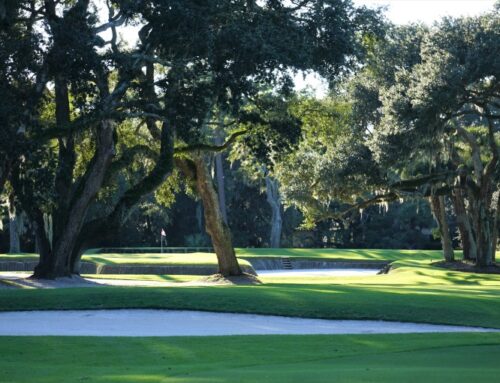Augusta National
GA, USA
More has been written about Augusta National than any other course save for The Old Course at St. Andrews. David Owen’s The Making of the Masters is a must-have book for any student of golf architecture as it best traces the changes over the past 70 years that have occurred to Alister MacKenzie’s design.
Little remains to be said.
- The 3rd and 5th green complexes are among the finest work that MacKenzie ever did; pity that they are rarely seen during the telecast of the Masters. The approach to a left hole location on the 3rd green is particularly taxing as the green is only 11 yards deep.
- Augusta National has gone through more changes since its inception than any of the world’s twenty or so greatest courses. To call it a MacKenzie course is false advertising as his features are essentially long gone and his routing is all that is left. [12]Cypress Point , [13]Royal Melbourne , and [14]The Valley Club of Montecito of today are far superior examples of MacKenzie’s design beliefs. Ironically, hosting the Masters has ruined one of MacKenzie’s most significant designs in as much of the money that the Club receives from the Invitational is plowed back into making changes to the course in a misguided effort to protect par.
- The energies expended on grooming Augusta National would repel the Good Doctor as the course is anything but natural. Among other things, MacKenzie would have little time for today’s sharp-edged, blah shaped bunkers as there is little attempt to integrate them into their natural surrounds. Also, he never intended for the 12th and 15th greens to become such hit-and-hope shots.
- Jones and MacKenzie both shared a passion for the Old Course at St. Andrews, and its influence is readily apparent in the initial design. However, in recent times, the work on the course has not borne this influence in mind. Reducing the width of play in the late 1990s with a tree planting program has been particularly disappointing. Club Chairman Hootie Jonson’s statement in August, 2003 that ‘The addition to trees at No. 11 continues our longstanding emphasis of accuracy off the tee’ highlights a complete ignorance as to why Augusta National was once MacKenzie’s most original design.
- Also, as at The Old Course, the ground game was meant to be the key at Augusta National. Unfortunately, it was doomed from the start. For instance, Cliff Roberts wanted to place a deep cross bunker across the 3rd green in 1933 – just one year after the course had opened! Jones and MacKenzie were against it and as MacKenzie wrote, ‘a cross bunker would convert it into an ordinary stereotyped hole and would nullify all the subtleties of the undulations of the approach to which we gave so much time and thought.’ While Jones and MacKenzie won that battle, MacKenzie’s death the next year and Jones’s ceasing to play much after 1938 with WWII and his syringomyelia illness didn’t bode well for the ground game. And sure enough, subsequent changes started to minimize the opportunity for the ground game. Another such example is that the wall of bunkers that were built across the 7th green were done in 1938. Finally, by the 1980s, the pace of the greens had become such as to negate any realistic chance of a ground game for one’s approach shots, a sure sign just how far the course has evolved from MacKenzie’s intent when he designed such green complexes as the 5th and 14th.
- With the ground game gone, the course was especially vulnerable to changes in technology, and this brought on a slew of changes from at least 15 different ‘architects’. The authors contention is that MacKenzie’s design would have held up far better without such changes. MacKenzie was quite cognizant of advances of technology, frequently included it in his writings, and appreciated that St. Andrews held up well in the change from the gutta to the Haskell ball in part because the skill to work the ball along the ground was not diminished. The surest way to challenge the best is to ask them to control the trajectory of their shots – and MacKenzie understood that better than anyone.
- At one point, Augusta National could have been considered amongst the two or three most innovative designs ever. The paucity of bunkers and its width of play were in stark contrast to the penal features found on the most revered U.S. courses at that time, including [15]Pine Valley and [16]Oakmont. However, the constant tinkering with the course has undermined this ‘less is more’ uniqueness.
Regardless of the design flaws that now exist, an invitation to play Augusta National remains golf’s most sought-after experience but fans of Alister MacKenzie would be better served to look elsewhere for a game.
The End




![The Park, West Palm (Lit 9) [2023]](https://golfclubatlas.com/wp-content/uploads/2024/12/IMG_7092-2-scaled-500x383.jpg)



